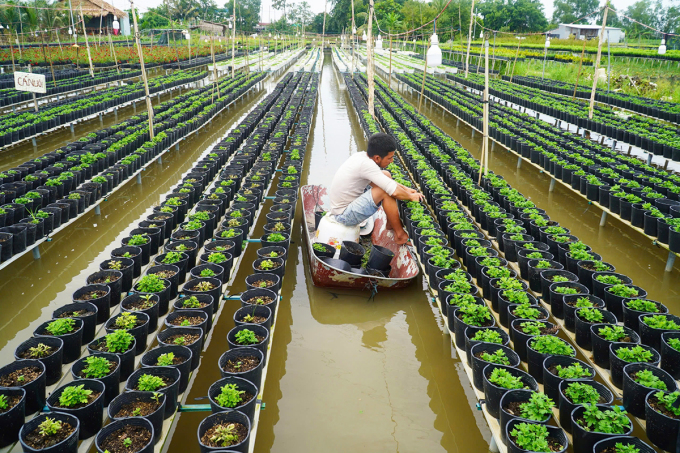The two largest flower villages in the West, Sa Dec (Dong Thap) and Cho Lach (Ben Tre), have planted Tet flowers, some of which are planted in larger quantities than last year.
In mid-October, Sa Dec flower village (Dong Thap) is the largest in the West in the year-end production season. This year, the flower village planted 70 hectares of Tet flowers, mainly focusing on traditional varieties such as chrysanthemum, marigold, auspicious, and almond. Gardeners planted about 100,000 baskets of colorful raspberry daisies, dozens of times more than last year.
Mr. Dang Van Ut, in An Hoa ward, Sa Dec city, planted 10,000 baskets of colorful raspberry daisies, 5 times more than last year. Flowers are sown from the full moon day of the 8th lunar month and begin to bud for the first time. New chrysanthemum varieties with red, orange, purple, pink colors, farmers have to use lights from planting until flowering.

Mr. Dang Van Ut canoe to take care of the colorful raspberry chrysanthemum garden. Image: Ngoc Tai
According to the garden owner, this year the rainy weather caused the trees to grow slowly, and high tides caused the flowers to become waterlogged, causing a loss of about 5%. “Last year was too hot, so this year I and many farmers planted colorful chrysanthemums,” Mr. Ut said, saying currently 20% of the output is ordered, the rest is waiting to be sold to traders near Tet.
Concerned about slow market consumption due to economic difficulties, Mr. Nguyen Van Hiep, living in Tan Khanh Dong commune, Sa Dec city, only planted 3,500 baskets of traditional raspberry chrysanthemums, down 1,500 baskets compared to last year. The garden owner also sowed nearly 500 baskets of marigolds, small ones sold on the full moon day of October.
“Traders eat a lot, but farmers who grow Tet flowers easily lose money,” Mr. Hiep said, adding that last year he lost about 100 million VND because flowers dropped in price and were difficult to sell.
Nearby, Ms. Nguyen Thi Bay, planted 3,000 pots of auspicious flowers to sell for Tet, equivalent to last year’s output. According to her, this year’s production costs are 10-20% higher than previous years, mainly straw fertilizer, which shows signs of shortage. Last year, she almost lost money on Tet flowers because the price suddenly dropped nearly 50%, and few traders asked to buy them.
According to the Economic Department of Sa Dec City, flowers for the 2025 Lunar New Year are in an area of about 70 hectares, accounting for 7% of the entire city’s flower and ornamental production area. Of which, there are 75,000 baskets of traditional raspberry chrysanthemums, 100,000 baskets of colored raspberries and 100,000 baskets of Taiwanese chrysanthemums.
At Cho Lach (Ben Tre), the largest flower village just after Sa Dec, these days along Highway 57 through Long Thoi and Vinh Thanh communes, farmers are entering the Tet season.
Mr. Tran Duy Khoa, 40 years old, Long Thoi commune, said the garden has 4,500 pots of yellow raspberry chrysanthemums. He sowed these chrysanthemums in mid-June, are now 3 months old, and the plants are growing well. Last year, raspberry chrysanthemums in his garden sold for 150,000-160,000 VND a pair, minus expenses, he made a profit of more than 150 million VND.

Traditional chrysanthemum and raspberry garden of Mr. Tran Duy Khoa. Image: Hoang Nam
This year, many farmers in the area switched to growing colorful raspberry chrysanthemums, with the selling price nearly double the traditional price. However, according to Mr. Khoa, the harvest time of colorful chrysanthemums is less than two months, but the seedlings are expensive and require a lot of work to light the bulbs.
“The most important thing is that many people are rushing to plant new varieties, so there is a possibility that supply exceeds demand and flowers will be dumped in the market,” Mr. Khoa said.
Mr. Tran Huu Nghi, Deputy Department of Agriculture and Rural Development Cho Lach, informed that the locality has 13,000 households growing flowers and fruit trees with more than 600 hectares, 15-17 million flower and ornamental plant products for Tet. Each year, there are about 8 million products of flowers alone.
This year the weather is quite favorable, not too extreme, so Tet flower products increased by about 10%. “Most local farmers have many years of experience, mainly selling to familiar traders, so they hope to have a good harvest and good prices this year,” Mr. Nghi said.
Ngoc Tai – Hoang Nam



